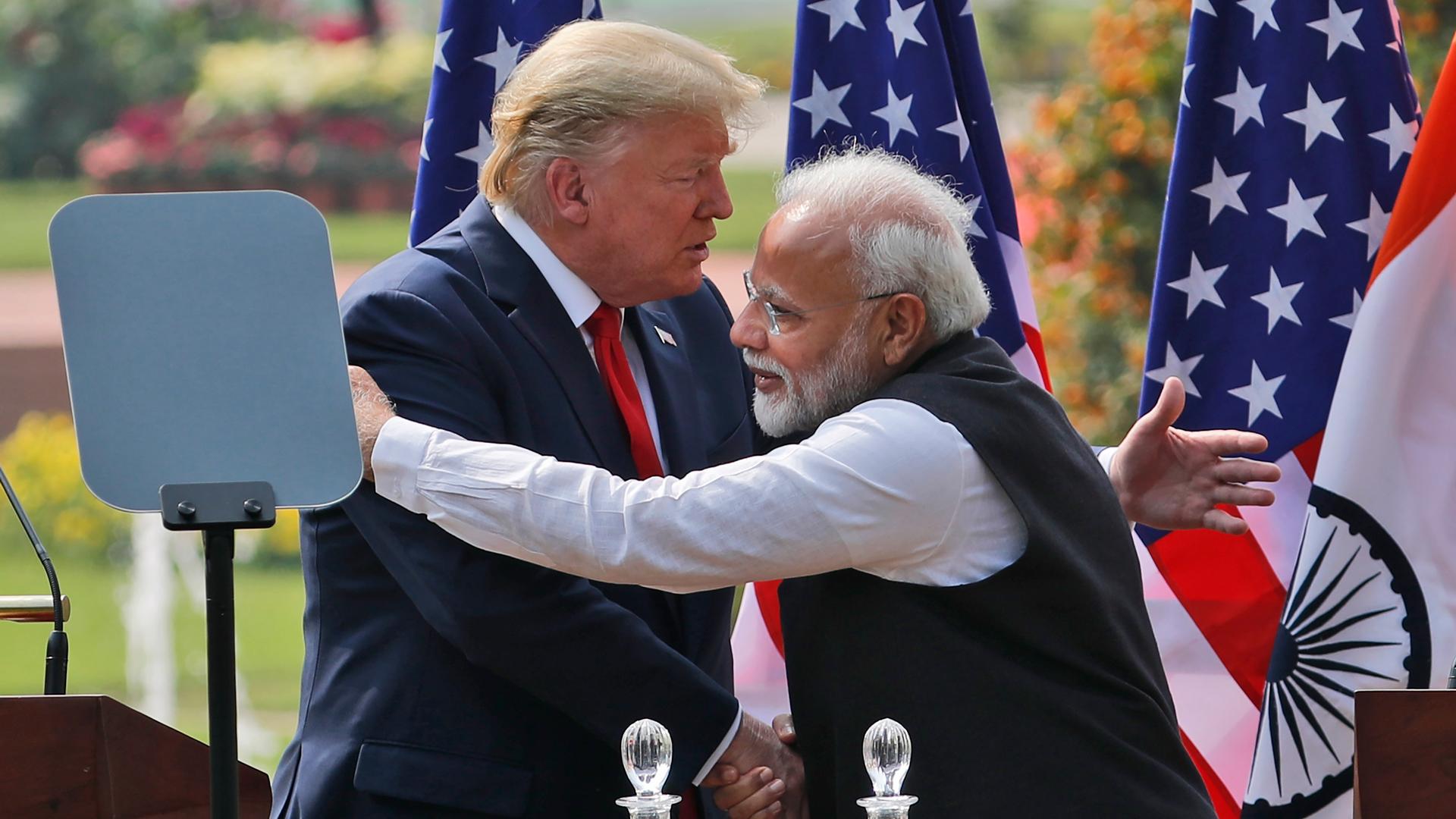Any attempts to revive this long-planned alliance will be ineffective in trying to counter China, and instead will simply be viewed as an alliance of Islamophobes.
The naked cynicism of geopolitical competition was exposed for all to see during US President Donald Trump’s recent visit to India.
To him, it mattered not that Hindutva mobs loyal to his host, Prime Minister Narendra Modi, were unleashing hell on Muslim-majority neighbourhoods on the other side of Delhi, as the two leaders met at Hyderabad House to discuss the future direction of the blossoming US-India alliance.
Trump’s gaze was riveted on China, at its most vulnerable in years because of the COVID-19 virus outbreak. It was a great time, and New Delhi the ideal setting, to stick the knife into President Xi Jinping’s back.
Seizing the moment, Trump announced that he and Modi would revive work on building a long-planned quadrilateral alliance, nicknamed the Quad, which would serve the specific purpose of preventing China from becoming the dominant political and economic power in Asia.
In addition to the US and India, it would comprise Japan and Australia, the other regional powers who feel deeply threatened by China’s ambitions.
Himself under intense pressure from Beijing since last August for annexing Indian-administered Kashmir – China is a party to the territorial dispute, along with close ally Pakistan – Modi enthusiastically declared the formation of a “comprehensive global strategic alliance” between India and the US.
He made no mention of China, but the implications were clear enough: the annual process of informal dialogue between Modi and Xi, launched in the ill-fated city of Wuhan in April 2018 after India backed down from a military standoff with China near their border with Bhutan the year before, was rendered practically useless by his Kashmir misstep.
Ahead of their second meeting in Tamil Nadu last October, Xi had publicly aligned his position on Kashmir with Pakistan’s Prime Minister Imran Khan, and doubled down on the snub by stopping over in Nepal on the way back from Chennai to seal Belt and Road Initiative (BRI) projects that would reduce Kathmandu’s long-standing dependency on connectivity provided by India.
Trump’s visit provided Modi with the opportunity to push back against his Chinese rival – all for the price of staging a “Namaste Trump” event at the new cricket stadium in his home state of Gujarat, and a $3 billion arms deal that was in the works.
Moreover, Trump’s flippant reaction to the communal carnage in Delhi all but endorsed the Modi administration’s fascist policies towards Indian Muslims, millions of whom stand to lose their citizenship under a controversial new law that has sparked nationwide protests.
Despite the loss of more than three dozen lives and hundreds of other casualties, the State Department’s senior diplomat for South Asia Alice Wells subsequently echoed Modi’s belated, disingenuous call for a halt to the communal violence sparked by Hindutva mob attacks against people peacefully protesting against the discriminatory law.
These denialist statements contrast starkly with Secretary of State Mike Pompeo’s attempt in early February to rally the five Central Asian states against the BRI by playing up Beijing’s brutal suppression of the indigenous Uyghur Muslim population of Xinjiang province. His brazen hypocrisy was exposed by Washington’s subsequent decision to add Kyrgyzstan and six Muslim-majority African countries to its travel ban list.
Trump’s reiteration of his offer to mediate the Kashmir dispute between India and Pakistan was just as duplicitous, considering his reluctance to even acknowledge the Hindutva-led strife in Delhi.
Pakistan’s government has sought to portray it as a diplomatic victory of sorts, but as the US Congressional Research Service noted recently, Trump’s initial offer last July probably prompted Modi to bring forward his plans to annex Kashmir in the first place.
His unconditional endorsement of Modi’s Hindutva administration would have been viewed with great interest by another such leader, Sri Lanka’s President Gotabaya Rajapaksa, whose successful election campaign was built upon stoking hatred of Muslims after last year’s horrific Easter terrorist attacks.
Muslim onlookers in South Asia and beyond would be justified in concluding that Trump’s visit to India was about cementing an alliance of populist Islamophobic administrations. India’s citizenship has already perturbed its relationship with the friendly government of Bangladesh.
Considering Pompeo’s duplicity vis-a-vis Uyghurs, they may have good reason to dismiss recently imposed US sanctions on several top Myanmar government officials for human rights atrocities against Rohingya Muslims as window-dressing.
Observers in Beijing would point out that, rather than any genuine concern for oppressed Muslims, the US sanctions are motivated by Myanmar’s long-standing alliance with China, highlighted by President Xi’s state visit in January.
The Chinese government has reacted angrily to Western portrayals of its handling of the COVID-19 crisis, describing them as blatantly racist.
Despite their shared Islamophobia and Sino-phobia, Trump and Modi have little more than rhetoric to back up their plans to transform the Quad into an effective mechanism to contain China.
First floated during George W Bush’s presidency, the concept has failed to gain traction because even close allies like Japan and South Korea suspect that the US while encouraging them to take a stand against China, may ultimately reduce its military presence in the Asia Pacific.
Trump’s withdrawal from the Trans-Pacific Partnership at the beginning of his presidency was seen as clear evidence that an inward-looking America could no longer be relied upon.
Likewise, Modi’s declaration of a strategic alliance is belied by India’s reluctance to regularly host the US Navy at its bases or to invite Australia to its annual naval exercises with the US and Japan, because it fears a Chinese backlash.
If the idea of the Trump-Modi get-together was to celebrate the xenophobia of their respective domestic support bases, it was a grand success.
But that is all it was.
Author: Tom Hussain
Tom Hussain is a journalist and analyst on Pakistan affairs and geopolitics in South Asia.
Source










Discussion about this post